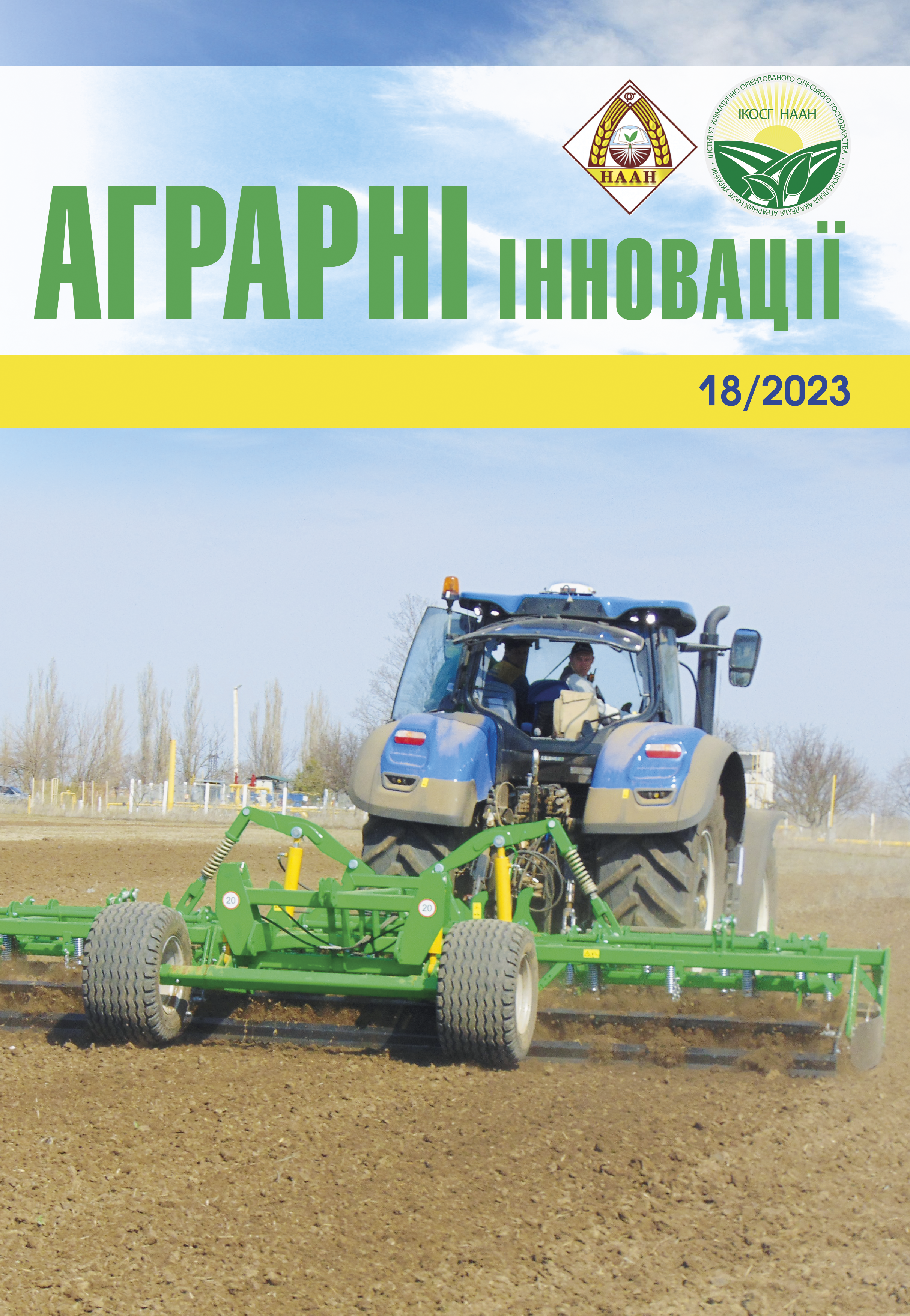LANDSCAPE AND ENVIRONMENTAL CONDITION AND WAYS OF RECOVERING THE FERTILITY OF DEGRADED LANDS OF THE SOUTHERN STEPPE OF UKRAINE
Abstract
The expansion of arable land areas in the steppe zone of Ukraine has led to the destabilization of agrolandscapes, the arableness of which currently reaches the highest indicators in the world. Due to the reduction of crops of perennial grasses and sugar beets in recent years, there has been a significant increase in the sown areas of winter wheat, corn, sunflower, winter rapeseed – crops that are in high demand on the market. The transformation of the natural steppe landscapes of the Southern Steppe into a zone for the production of grain and industrial crops with a significant reduction in the sown areas of fodder crops caused global negative phenomena in the existing agrolandscapes and, above all, degradation and a significant decrease in soil fertility, which led to the emergence of significant ecological and socio-economic problems. The aim of the research was the agrobiological substantiation of the modern landscapeecological state of the agricultural lands of the Southern Steppe of Ukraine and the development of resourcesaving technologies for the cultivation of highly productive perennial grasses for fodder purposes with the temporary or permanent conservation of arable land removed from cultivation under conditions of natural moisture. Methods. The field experiments were carried out at the State Research Farm «Kopani» of the Institute of Irrigated Agriculture of the NAAS of Ukraine (Kherson). Cultivation of arable land was carried out with perennial leguminous and cereal grasses, the most adapted to the natural and climatic conditions of the subzone of the southern Steppe of Ukraine. Depending on the terms of use, the herbal mixture included multiflowered fenugreek (Lolium multiflorum Lam.) of the Yaroslav cultivar and sand safflower (Onobrychis arenaria Kit.) of the Ingulsky cultivar, eastern sedge (Festuca orientalis (Hack.) V. Krecz.) of the Domenica cultivar and variable alfalfa (Medicago varia T. Martyn.) of the Veselka cultivar, thornless cornflower (Bromopsis inermis (Loyss.) Holub) of the Tavriyskyi cultivar and variable alfalfa of the Veselka cultivar, medium heather (Elytrigia intermedia (Host) Nevski) of the Vitas cultivar and variable alfalfa of the Unitro cultivar. We determined the indicators of potential evaporation and moisture deficit over the years of research, the content of dry matter, the density of grass stands, the change in species botanical composition, the output of feed units, gross and exchangeable energy, the amount of fixed biological nitrogen, as well as the fractional composition of nitrogen in the soil. The results. It was established that the maximum of the digestible protein yield during all years of using perennial grasses was facilitated by single-species crops of variable alfalfa – 0.30–0.62 t/ha, as well as by crops of binary alfalfa-cereal grass mixtures – 0.30–0.59 t/ha, which significantly depended on participation in the species botanical composition of variable alfalfa. Cultivation of single-species crops of variable alfalfa and sandy safflower and their grass mixtures with cereal grasses for three years of use made it possible to obtain green fodder balanced in terms of digestible protein, without applying mineral fertilizers and to have better predecessors for grain ear crops during all years of cultivation. After the three-year use of variable alfalfa after seed inoculation with the complex biopreparation Eсovital, the greatest accumulation of all nitrogen fractions occurred in the 0–20 cm and 20–40 cm soil layers compared to other sections of the crop rotation. Conclusion. The creation of highly productive singlespecies agrophytocenoses of alfalfa and sandy safflower and binary alfalfa-cereal and safflower-cereal grass mixtures in combination with the introduction of the novel biotechnologies will contribute to restoring the fertility of degraded lands and stabilizing agricultural production.
References
2. Балюк С.А., Медведєв В.В., Тараріко О.Г. Про стан родючості ґрунтів України. Посібник українського хлібороба. Київ, 2011. Том 1. С. 41–69.
3. Збір урожаю сільськогосподарських культур, плодів, ягід та винограду в регіонах України за 2015 рік. Київ: Державна служба статистики України, 2016. 93 с.
4. Ібатуллін І.І., Жукорський О.М. Довідник з повноцінної годівлі сільськогосподарських тварин; за ред. Ібатулліна І.І. Київ: ІТ НААН, 2016. 300 с.
5. Медведєв В.В. Стан родючості ґрунтів України та прогноз його змін за умов сучасного землеробства. Харків : Штрих, 2001. 98 с.
6. Медведовський О.К., Іваненко П.І. Енергетичний аналіз інтенсивних технологій в сільськогосподарському виробництві. Київ : Урожай, 1988. 206 с.
7. Основні економічні показники виробництва продукції сільського господарства в сільгосппідприємствах за 1990–2016 рр. URL : www.ukrstat.gov.ua (дата звернення 14.03.2023).
8. Рижук С.М., Сорока В.І., Жилкін В.А. Вилучення з інтенсивного обробітку малопродуктивних земель та їхнє раціональне використання. Київ: Аграрна наука, 2000. 39 с.
9. Романенко В.А. Розрахунок осінньої вологості ґрунту за універсальним співвідношенням для великої площі. Наукові праці Українського науково-дослідного гідрометеорологічного інституту. 1961. Вип. 3. С. 12–25.
10. Сайко В.Ф., Бойко П. І. Сівозміни у землеробстві України. К.: Аграрна наука, 2002. 146 с.
11. Статистичний щорічник за 2020 рік. Київ : Державна служба статистики України, 2021.
12. Тараріко О.Г. Теорія і практика удосконалення структури землекористування в контексті консервації еродованих орних земель і збільшення площі кормових угідь. Корми і кормовиробництво. 1999. Вип. 46. С. 72–78.
13. Ушкаренко В.О. та ін. Статистичний аналіз результатів польових дослідів у землеробстві. Херсон: Айлант, 2013. 381 с.






